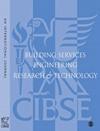The potential for the Passive House standard in Longyearbyen – the High Arctic
IF 1.8
4区 工程技术
Q3 CONSTRUCTION & BUILDING TECHNOLOGY
Building Services Engineering Research & Technology
Pub Date : 2021-05-01
DOI:10.1177/0143624421996989
引用次数: 3
Abstract
Passive building design reduces a building’s energy consumption through mainly non-mechanical design strategies. The Passive House (or Passivhaus) Standard certifies such buildings that comply with its strict energy performance criteria. Achieving the Standard is very challenging for dwellings in extreme climates. There is limited knowledge of the Standard’s potential in Arctic regions, particularly the High Arctic. Through a review of the literature and energy modelling of a hypothetical dwelling, the challenges in achieving the Standard in Longyearbyen (78°N), Norway are investigated. Very low temperatures and 112 days without daylight create a high heating demand. Whereas previous studies measured actual building performances or used simple calculations, the findings in this investigation show the limitations of individual design parameters and technical limits of the building envelope. In theory the Standard can be achieved in Longyearbyen; however, the potential in practice is low due to the very tight margins in the heating criteria. The results show the significant impact of applying contextual (climatic) adjustments to the boundary conditions of the Standard. The investigation could contribute to a discussion on modifying the Passive House Standard for dwellings in the High Arctic and improving building design for the region. Practical application : Current knowledge regarding energy efficient building performance in Arctic climates is limited, while the urgency for improved efficiencies is extremely high. The modelling in this work shows the valuable impact of contextual adjustments to the Passive House boundary conditions; the impact of individual design parameters; and the potential for significant energy savings through adopting passive house principles for dwelling design in Longyearbyen or similar climates. This investigation could encourage new policy making, additional research and the development of an optimized Passive House Standard that considers High Arctic climate conditions, thus encouraging new energy efficient building construction in cold climates.北极高地朗伊尔城被动式住宅标准的潜力
被动式建筑设计主要通过非机械设计策略来降低建筑的能耗。被动式房屋(或被动式房屋)标准认证这些建筑符合其严格的能源性能标准。对于极端气候下的住宅来说,达到这个标准是非常具有挑战性的。人们对“标准”在北极地区,特别是北极高地的潜力了解有限。通过对文献和假设住宅的能源模型的回顾,研究了在挪威朗伊尔城(78°N)实现标准的挑战。非常低的温度和112天没有日光,产生了很高的供暖需求。先前的研究测量了实际的建筑性能或使用简单的计算,而本次调查的结果显示了单个设计参数的局限性和建筑围护结构的技术限制。理论上,该标准可以在朗伊尔城实现;然而,由于加热标准的边际非常窄,因此在实践中潜力很低。结果表明,将环境(气候)调整应用于标准的边界条件会产生重大影响。该调查有助于讨论修改北极地区被动式住宅标准和改进该地区的建筑设计。实际应用:目前关于北极气候下节能建筑性能的知识有限,而提高效率的紧迫性非常高。这项工作中的建模显示了环境调整对被动屋边界条件的宝贵影响;个别设计参数的影响;以及通过在朗伊尔城或类似气候条件下采用被动式房屋原则进行住宅设计来节省大量能源的潜力。这项调查可以鼓励新的政策制定,额外的研究和优化被动式房屋标准的发展,考虑到北极气候条件,从而鼓励在寒冷气候下建造新的节能建筑。
本文章由计算机程序翻译,如有差异,请以英文原文为准。
求助全文
约1分钟内获得全文
求助全文
来源期刊

Building Services Engineering Research & Technology
工程技术-结构与建筑技术
CiteScore
4.30
自引率
5.90%
发文量
38
审稿时长
>12 weeks
期刊介绍:
Building Services Engineering Research & Technology is one of the foremost, international peer reviewed journals that publishes the highest quality original research relevant to today’s Built Environment. Published in conjunction with CIBSE, this impressive journal reports on the latest research providing you with an invaluable guide to recent developments in the field.
 求助内容:
求助内容: 应助结果提醒方式:
应助结果提醒方式:


